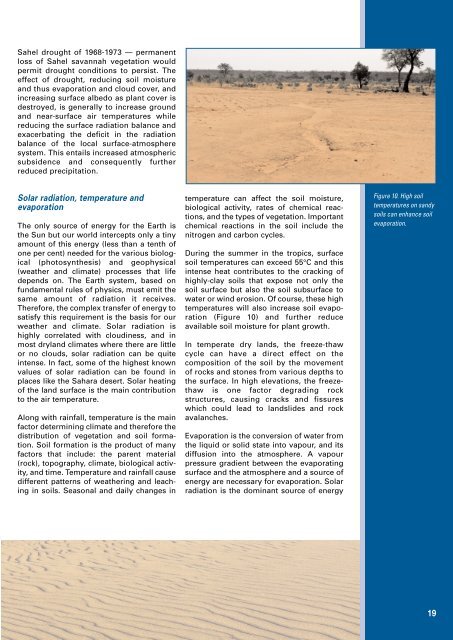Climate and Land Degradation - WMO
Climate and Land Degradation - WMO
Climate and Land Degradation - WMO
Create successful ePaper yourself
Turn your PDF publications into a flip-book with our unique Google optimized e-Paper software.
Sahel drought of 1968-1973 — permanent<br />
loss of Sahel savannah vegetation would<br />
permit drought conditions to persist. The<br />
effect of drought, reducing soil moisture<br />
<strong>and</strong> thus evaporation <strong>and</strong> cloud cover, <strong>and</strong><br />
increasing surface albedo as plant cover is<br />
destroyed, is generally to increase ground<br />
<strong>and</strong> near-surface air temperatures while<br />
reducing the surface radiation balance <strong>and</strong><br />
exacerbating the deficit in the radiation<br />
balance of the local surface-atmosphere<br />
system. This entails increased atmospheric<br />
subsidence <strong>and</strong> consequently further<br />
reduced precipitation.<br />
Solar radiation, temperature <strong>and</strong><br />
evaporation<br />
The only source of energy for the Earth is<br />
the Sun but our world intercepts only a tiny<br />
amount of this energy (less than a tenth of<br />
one per cent) needed for the various biological<br />
(photosynthesis) <strong>and</strong> geophysical<br />
(weather <strong>and</strong> climate) processes that life<br />
depends on. The Earth system, based on<br />
fundamental rules of physics, must emit the<br />
same amount of radiation it receives.<br />
Therefore, the complex transfer of energy to<br />
satisfy this requirement is the basis for our<br />
weather <strong>and</strong> climate. Solar radiation is<br />
highly correlated with cloudiness, <strong>and</strong> in<br />
most dryl<strong>and</strong> climates where there are little<br />
or no clouds, solar radiation can be quite<br />
intense. In fact, some of the highest known<br />
values of solar radiation can be found in<br />
places like the Sahara desert. Solar heating<br />
of the l<strong>and</strong> surface is the main contribution<br />
to the air temperature.<br />
Along with rainfall, temperature is the main<br />
factor determining climate <strong>and</strong> therefore the<br />
distribution of vegetation <strong>and</strong> soil formation.<br />
Soil formation is the product of many<br />
factors that include: the parent material<br />
(rock), topography, climate, biological activity,<br />
<strong>and</strong> time. Temperature <strong>and</strong> rainfall cause<br />
different patterns of weathering <strong>and</strong> leaching<br />
in soils. Seasonal <strong>and</strong> daily changes in<br />
temperature can affect the soil moisture,<br />
biological activity, rates of chemical reactions,<br />
<strong>and</strong> the types of vegetation. Important<br />
chemical reactions in the soil include the<br />
nitrogen <strong>and</strong> carbon cycles.<br />
During the summer in the tropics, surface<br />
soil temperatures can exceed 55°C <strong>and</strong> this<br />
intense heat contributes to the cracking of<br />
highly-clay soils that expose not only the<br />
soil surface but also the soil subsurface to<br />
water or wind erosion. Of course, these high<br />
temperatures will also increase soil evaporation<br />
(Figure 10) <strong>and</strong> further reduce<br />
available soil moisture for plant growth.<br />
In temperate dry l<strong>and</strong>s, the freeze-thaw<br />
cycle can have a direct effect on the<br />
composition of the soil by the movement<br />
of rocks <strong>and</strong> stones from various depths to<br />
the surface. In high elevations, the freezethaw<br />
is one factor degrading rock<br />
structures, causing cracks <strong>and</strong> fissures<br />
which could lead to l<strong>and</strong>slides <strong>and</strong> rock<br />
avalanches.<br />
Evaporation is the conversion of water from<br />
the liquid or solid state into vapour, <strong>and</strong> its<br />
diffusion into the atmosphere. A vapour<br />
pressure gradient between the evaporating<br />
surface <strong>and</strong> the atmosphere <strong>and</strong> a source of<br />
energy are necessary for evaporation. Solar<br />
radiation is the dominant source of energy<br />
Figure 10. High soil<br />
temperatures on s<strong>and</strong>y<br />
soils can enhance soil<br />
evaporation.<br />
19












![View full document [PDF 988.55 KB] - PreventionWeb](https://img.yumpu.com/47733942/1/184x260/view-full-document-pdf-98855-kb-preventionweb.jpg?quality=85)
![View full document (in French) [PDF 4.96 MB] - PreventionWeb](https://img.yumpu.com/47223870/1/184x260/view-full-document-in-french-pdf-496-mb-preventionweb.jpg?quality=85)


![View full document [PDF 25.02 MB] - PreventionWeb](https://img.yumpu.com/44204570/1/190x234/view-full-document-pdf-2502-mb-preventionweb.jpg?quality=85)
